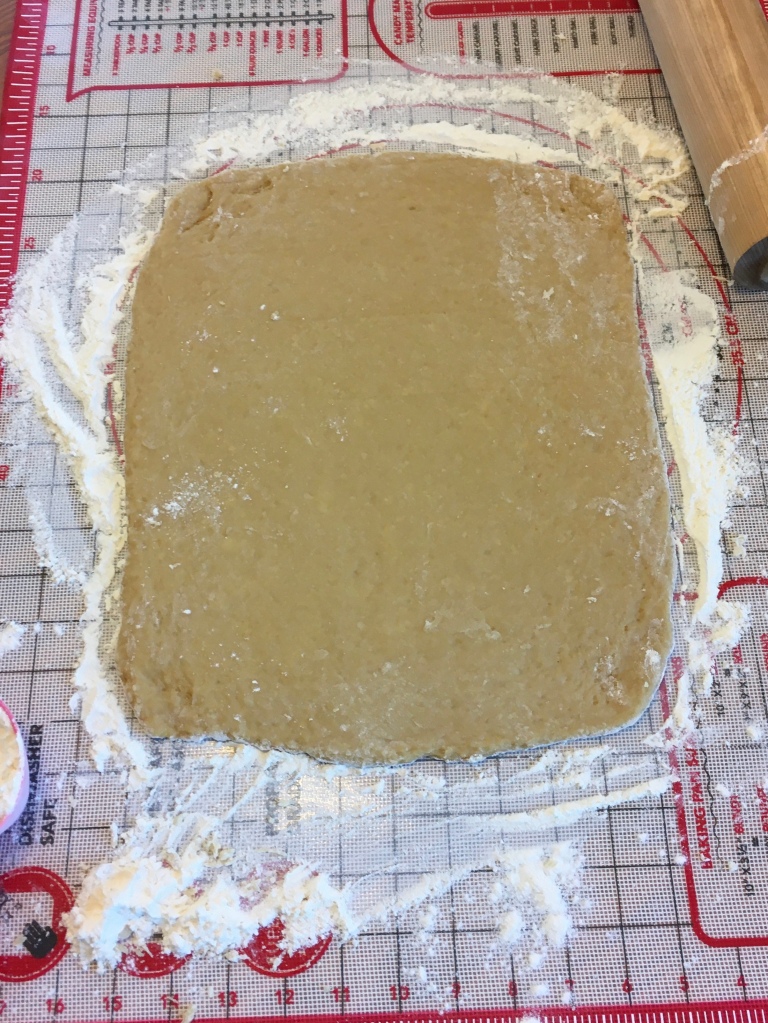This recipe comes from The Woman Suffrage Cook Book, a fundraising cookbook first sold at the 1886 Woman Suffrage Festival and Bazaar in Boston to raise money for the Massachusetts Woman Suffrage Association.
Fundraising cookbooks such as this one did more than just raise money for the women’s suffrage cause; they helped change minds, too. Opponents called suffragists “unwomanly” and argued that women who wanted the vote were abandoning their duties as wives and mothers. Anti-suffrage propaganda depicted men forced to take over household tasks such as cooking, cleaning, and caring for children.
![[Image: At the top of this vertical postcard is a bold headline that reads, "LIFE IS JUST ONE DAMN THING AFTER ANOTHER" in block, bold, red font. Under the headline a man in his dress-pants, white dress shirt with collar, red cravat, shining gold tie pin, and gold cufflinks. He is smoking a cigar and looking at the viewer angrily. Forehead wrinkled and eyebrows arched. His is rolling out dough with a rolling-pin and rocking a crying baby with his right, brown dress-shoe clad foot. The baby is in a wooden rocker and is dressed in baby blue and white. On the kitchen table (next to the dough being rolled out) is a large bowl with dough and a wooden spoon sitting inside, and tin flour sifter. On the wall behind the man is a portrait of a woman from the decollatage up. She has blond hair swept up and covered with a wide, black hat. The hat is adorned with a red flower. The wife is dressed in pink. On the bottom of the portrait are printed, "Our Presidentess." Another framed hanging reads, "WHAT IS HOME WITHOUT A SUFFRAGETTE." On the bottom right the card is signed, "Wall." On the bottom left is printed, "COPYRIGHT THE ULLMAN MFG CO."] Print. Four-color on cream cardstock. Private. 14x9 cm.](https://history-in-the-making.com/wp-content/uploads/2021/07/138a_life_is_just_one_damn_thing_after_another_3_front.jpg?w=676)
By creating cookbooks, suffragists refuted these arguments, showing that women could vote and still be successful in the domestic sphere at the same time. In an article reprinted in The Woman’s Journal (which was closely associated with the Massachusetts Woman Suffrage Association, the publishers of the cook book), the newspaper The Evening Record called The Woman Suffrage Cook Book “proof that, even if they wish to vote, the suffragists cherish a feminine interest in culinary matters.” The article suggested that the cookbook would not only convert men to the women’s suffrage cause, but would also convince indifferent or anti-suffrage women, because “there is no bond which draws women more closely together than a common interest in the making of ‘things to eat.'”

Coffee cakes (1/2 recipe):
- 1.5 eggs
- 1 cup brown sugar
- 1/2 cup butter
- 1/2 cup milk
- 1/2 tsp baking soda
- 1 tsp cream of tartar
- 3 – 3 1/4 cups flour, plus more for rolling
- powdered sugar
- cinnamon
- granulated sugar
- Heat the butter and milk together just until the butter melts. Set aside to cool.
- In a large bowl, whisk the eggs until yellow and frothy.
- Whisk in the brown sugar, then whisk in the butter and milk.
- Stir in the baking soda and cream of tartar.
- Stir in the flour until the dough is stiff enough to roll.
- Turn out the dough onto a floured surface and knead lightly.
- Roll out to about a 10×14 inch rectangle, or until dough is about 1/2 inch thick.
- Sprinkle with powdered sugar and cinnamon.
- Roll up from the long side and cut slices about half an inch thick (mine ended up closer to an inch thick; the dough was too soft to cut really thin slices).
- Dip each slice in a bowl of granulated sugar, then place on a parchment paper-covered baking sheet with the sugared side up.
- Bake at 375 degrees for about 15 minutes, until sides are firm and starting to turn golden.



Tasting notes:
Although they don’t have any icing, these are really very similar to modern cinnamon rolls. Because they use baking soda instead of yeast, they have a slightly denser texture than most cinnamon rolls. The brown sugar in the dough adds a nice flavor; with three different types of sugar, they are definitely pretty sweet overall. Since they have no icing or butter, they are a little drier than cinnamon rolls – which just makes them even better to have alongside a beverage like coffee, as the name suggests. They were still pretty good the next day, but were at their tastiest when fresh.
These are definitely proof (not that I needed any) that suffragists can cook!

References:
Burr, H.A. (Ed.) (1890). The woman suffrage cook book (2nd edition). Boston: Mrs. Hattie A. Burr. https://n2t.net/ark:/85335/m5dm30
Derleth, J. (2018). “Kneading politics”: Cookery and the American woman suffrage movement. The Journal of the Gilded Age and Progressive Era, 17, 450-474. https://doi.org/10.1017/S1537781418000063
MSU Libraries. (n.d.) Burr, Hattie A. https://d.lib.msu.edu/content/biographies?contributor_name=Burr%2C+Hattie+A.
The Woman Suffrage Cookery Book. (1886, Nov. 6). The Woman’s Journal, 17(45), p. 358-359. https://iiif.lib.harvard.edu/manifests/view/drs:49687852$366i


Love the recipe and the vintage postcard!
LikeLiked by 1 person
These remind me of cinnamon rolls because of the shape XD looks yum!
LikeLiked by 1 person
[…] term coffee cake itself is a bit of a misnomer, as traditional recipes seldom include coffee as an ingredient. Instead, the name reflects the cake’s role as a […]
LikeLike